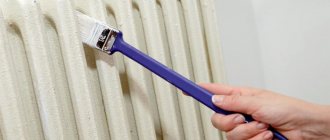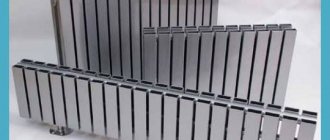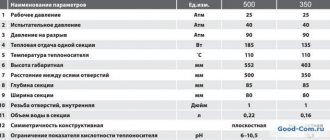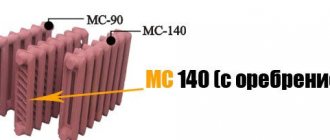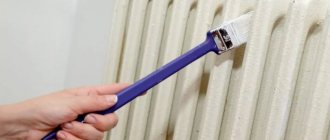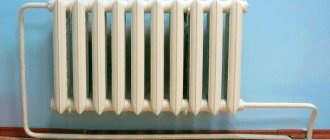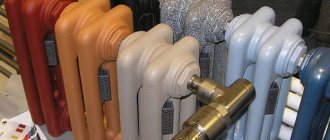Modern technological progress has practically not affected cast iron heating radiators in all 167 years of their existence. Consumers still choose these devices due to the many positive characteristics of the products.
And even some shortcomings do not prevent the installation of cast iron batteries when installing heating systems. Next, we will talk in detail about all the advantages and disadvantages of cast iron radiators, as well as the characteristics that you need to pay attention to before purchasing.
Pros and cons of cast iron radiators
Despite all the external changes, the principle of operation of cast iron radiators remains the same, so in the century and a half that has passed since their invention, the batteries have changed little. Nothing surprising: the design has been proven over many years of service and there is no point in radically changing it. Compared to radiators made from other materials, cast iron ones have a number of advantages and disadvantages - these should be taken into account first of all when choosing.
The advantages are:
- High resistance of cast iron to corrosion. It does not require high-quality coolant, and this is very important in domestic conditions.
- Due to their large internal cross-section, they rarely need to be cleaned.
- Their residual heat transfer is high, so even after switching off they continue to heat for quite a long time.
- They can be used for up to half a century.
- Their cost is significantly lower than that of radiators made from other materials.
As for the disadvantages , the main ones are:
- Due to the fragility of cast iron, thick walls have to be made, as a result of which a significant part of the heat is spent on heating the material, and the heat transfer is quite low.
- Heavy weight - one section can weigh 5-10 kilograms, so a whole radiator is not so easy to transport and install.
- More coolant is required, so cast iron radiators heat up more slowly than their counterparts, and the temperature cannot be adjusted quickly.
Product design
Cast iron heating radiators are several separate sections connected into a single product. The number of sections depends on the volume of the heated room.
Radiators are made by casting from gray cast iron at atmospheric pressure in prepared molds. Cast iron was the cheapest and most accessible, and the technology was easy to replicate - because of this, cast iron radiators were most widespread in the past.
The sections are connected using nipples and gaskets. Nipples, plugs and threaded connecting plugs are made from especially durable malleable cast iron of special grades.
Principle of operation
Radiators are convection-radiation devices. The coolant, circulating in the cavities of the sections, heats them. Convection currents of heated air are created around the surface, and part of the energy is emitted into space in the form of infrared rays.
It is undesirable to cover the radiator with additional screens, so when choosing, pay attention to the appearance of the product.
Important! The larger the radiator surface, the better heat transfer (power) it has. Pay attention to the design features when purchasing.
What characteristics should you look for when choosing cast iron radiators?
Despite the simplicity of the design, there are a number of characteristics by which they should be compared before purchasing. Among them:
Connection type – there is almost no variety here; the models presented in stores almost always have a side connection. It is most effective because it allows the radiator to warm up evenly: when it cools, the coolant settles, and the warmer one rises, then they change again.
Type of construction – wall or floor. Radiators of the first type are more common, since they are convenient to install in the space under the window sill. However, floor-standing ones are also gradually gaining popularity, because they can take up no more space than wall-mounted ones, and most importantly, they do not require a load-bearing wall nearby.
Heat transfer - it determines how much heat the radiator will transfer to the room. In addition to power, it is also determined by some other factors, as a result of which the actual figure is often lower than that indicated by the manufacturer - and this is worth taking into account.
Coolant volume - in this regard, cast iron radiators are inferior to aluminum ones; for the same heat transfer, approximately 2.2 times more water needs to be poured into them. The volume itself is not so important; it is used to calculate power.
The maximum operating temperature is 110 ˚С, which is quite enough to connect to the heating network.
The maximum operating pressure should not be lower than 8 atmospheres, preferably 10, otherwise the radiator will not last long in Russian conditions. Pressure testing is created during system checks. It should be at least 12 atmospheres, preferably 15-18.
Connection diameter - depends on parameters such as power and number of sections. Standard options are ½, ¾ and 1 inch pipes . Center distance - it must correspond to the distance between the inlet and outlet pipes. This condition is not always met in models manufactured abroad, which adds to the hassle, since such pipes must be adapted. The usual is 50 cm.
Dimensions - you need to know them so that the batteries fit exactly in the space between the window sill and the floor. It is worth leaving small reserves: at least 10 cm to the window sill, and 7 cm to the floor. Thus, nothing will interfere with the spread of heat through the air.
Disconnecting the first battery section
Take the radiator disassembly key. If you don't find such a key on sale, you can try making it yourself. To do this, you will need a piece of reinforcement with a diameter of 20 mm and a length of at least 60 cm. In order to unscrew the nipple, we need to flatten one of the ends of the reinforcement to such a state that it is wider than 26 mm, but narrower than 32 mm. To do this, take the burner you have, which you used to heat the plugs. Heat a section of reinforcement about 4 cm long at either end. After heating, use a hammer to shape the tip into a flat shape. If necessary, repeat the heating procedure and hammer the reinforcement section again.
The key can also be made from a piece of pipe with a diameter of 20 mm. To do this, give one end of the pipe a flat shape according to the specified dimensions. When using the factory key to disassemble radiators, you do not need additional equipment. If you have a homemade wrench made from fittings or pipes, it is most convenient to twist it using a pipe wrench. It has enough leverage to rip the nipple out of place. Insert the key into the radiator to a depth sufficient to engage the key and nipple tabs.
Next, start unscrewing the nipple in the direction in which you unscrewed the plug.
You can begin to disassemble the radiator both from the side of the blind plugs and from the side of the through plugs. Remember that they have left and right hand threads respectively. If you unscrew the nipple from the side of the blind plug, then you also twist the nipple clockwise, like a plug. Otherwise, you will break the nipple antennae, and then you will only be able to disassemble the battery using a hacksaw.
Make one or one and a half turns. Next, in the same way, make one or one and a half turns at the bottom of the battery. Unscrew each nipple in turn until the section is completely removed.
You cannot immediately try to unscrew the nipple completely. The section, like the nipple, is made of cast iron and is very fragile. You need to unscrew them gradually so that they don’t burst. If the fastener does not yield, heat the joint with a torch. This will help, as in the case of the cork.
In order to disconnect more than one section, it is not necessary to unscrew each section in turn. You can go straight to the section you need. To do this, use a radiator dismantling wrench to measure the distance to the desired nipple. Make a mark on the key using chalk or a marker. This will allow you not to miss the desired depth at which you need to insert the key. Next, start unscrewing the nipple in the same way as if you were unscrewing one section. It is important to have a key length of at least 50-60 cm in order to easily reach the desired section of the radiator and remove it.
How to calculate the required power?
The main thing you need to know before installing a radiator is how much power is required to heat the room. It is advisable to calculate it as accurately as possible so that you don’t have to freeze, but also so that it doesn’t get too hot. It is believed that heating a square meter requires from 100 to 120 W of power (depending on the area, but without taking into account extreme conditions, for example, in the Far North). If the windows in the room are equipped with energy-saving thermal package, the power can be reduced by 15%.
If the coolant temperature is below 70 °C, you need to add 5-15% depending on how much lower it is. If the room is corner, you should add 10%. There are other factors that need to be taken into account, if they are clearly expressed: the total area of all rooms, because they influence each other, how insulated the walls are, and the like - only a simplified version of the calculation will be presented here.
If the area of the room is 18 square meters, it is located in the middle zone and frosts in winter can be quite severe, while it is corner and has ordinary windows, then the calculation will be as follows: for the base figure we take 120 W, add 10% and get 132, and then multiplied by the area comes out to 2376. This is exactly what the total radiator power should be. Now it should be divided by the power of the section. If it is 150 W, then you need to purchase 16 sections.
Top 4 cast iron radiators
There are many models on the market, of which we have selected four: they all have the optimal combination of parameters and price.
The best wall-mounted cast iron radiators
STI Nova 500/85
It has a modern utilitarian design with convenient dimensions: 580x85x60 mm, which will allow it to be installed in almost any room. Withstands operating temperatures up to 150 ˚С, pressure – 12 and 18 atm for working and crimping (further these characteristics will be given in the same order without specification).
Such indicators provide a large margin of safety and long-term operation even in difficult conditions. Lightweight cast iron is used, so the section weighs only 4.2 kg with a power of 150 W and a coolant volume of just over 0.5 liters. With such characteristics, it costs very moderately: about 6,000 – 6,500 rubles.
Price: ₽ 6,000
STI Nova 500
RETROstyle TOULON 900/70
In full accordance with the name of the brand, these radiators are made in a “retro” style, while being highly elongated in shape: the section height is 980 mm with a thickness and width of 70 and 60 mm, respectively.
Their dimensions and design somewhat limit their use, but they fit perfectly into loft-style apartments. The mass of the section is 6.1 kg, heat transfer at 70 ˚C is 180 W, pressure is 10 and 15 atm. The margin for these parameters is sufficient for the radiator to serve for a long time in the conditions of domestic heating networks. The cost is about 7,500 rubles.
Price: ₽ 7,500
RETROstyle TOULON 900/70
RETROstyle TOULON 500/160
Another model of the same brand looks simpler, but is also well suited for loft-style rooms. The design is compatible with TOULON 900/70, so they can be used in the same apartment, because it is not possible to install extended batteries everywhere. This one has a standard height - 580 mm, but the thickness is greater - 160 mm.
It can withstand the same pressure, and its heat output is even higher - 192 W. It costs 5,200 rubles, the manufacturer gives a five-year warranty, although in reality the service life can be much longer, up to 50 years.
Price: ₽ 5,200
RETROstyle TOULON 500/160
The best floor-standing cast iron radiator
Dokum Tower 6049
The unusual design of this product can add zest to the interior, and its dimensions will make it possible to fit even where most other radiators will not fit - the height of the battery is only 490 mm. The center distance is also less than the standard - 350 mm, this allows you to more accurately select the power, which is convenient for small spaces.
Disadvantage: the pressure indicators are low, 8 and 12 atm, so you need to check in advance whether this will be enough for your network. Such parameters are compensated by the fact that the radiator costs less than the others considered - 3,000 rubles.
Price: ₽ 3,000
Dokum Tower 6049
What is the price
The cost of cast iron radiators will depend on the overall dimensions of the product, manufacturer and brand. The oldest model of domestic production is considered to be MC 140. A separate section of such a battery costs an average of 340 rubles per piece, the price depends on the markup of resellers and the region.
Also, cast iron batteries from foreign manufacturers (Italy, Czech Republic, Spain, Turkey) are supplied to the domestic market. Such devices differ from domestic ones in various respects. For example, the capacity of the section of the Czech Termo battery is almost two times smaller - 800 milliliters, while the domestic MS 140 holds 1.4 liters of water.
Radiator Nostalgia (retro) in the interior
The price of one section of foreign cast iron radiators in rubles is as follows:
- Brand Kiran 92/500 – from 335 rubles;
- Manufacturer Viadrus termo 500/95 – no less than 450 rubles;
- Company Nostalgia (retro) 500/180 – from 2120 rubles;
- Demrad 350 brand – no less than 400 rubles per section.
FAQ
Do cast iron radiators need to be flushed? Although cast iron radiators require almost no maintenance, they still need to be washed occasionally: the internal channels gradually become clogged, which is why they begin to give off heat less well. If the room used to be comfortable, but over the years it became cold, this is probably the reason. Can they be repaired?
Most breakdowns can be fixed. Thus, a leak can be sealed using putty and a metal clamp, and in sectional models you can simply replace the faulty section.
Design features
When you choose radiators, there are several important points to consider. If you choose sections of radiators, you can increase the heating area if necessary. If the design of the heating radiator is panel, or it is a convector, then you will not change it structurally. When calculations are first made, it is very difficult to take into account all the nuances that will affect the amount of heat required for each individual room. And if the heating battery device is sectional, then this will make it possible to reduce and increase the number of sections, and replace those elements that have failed.
